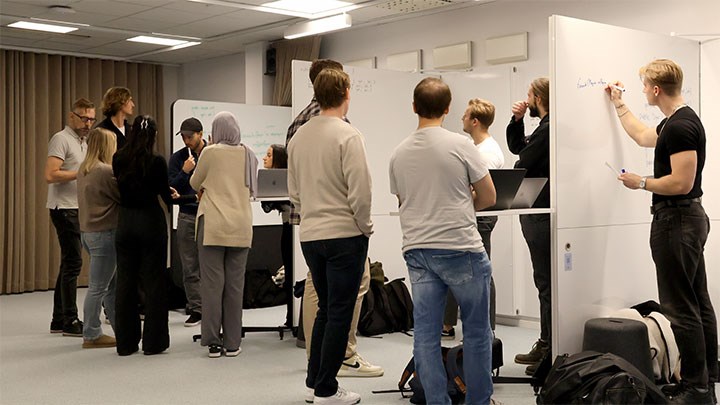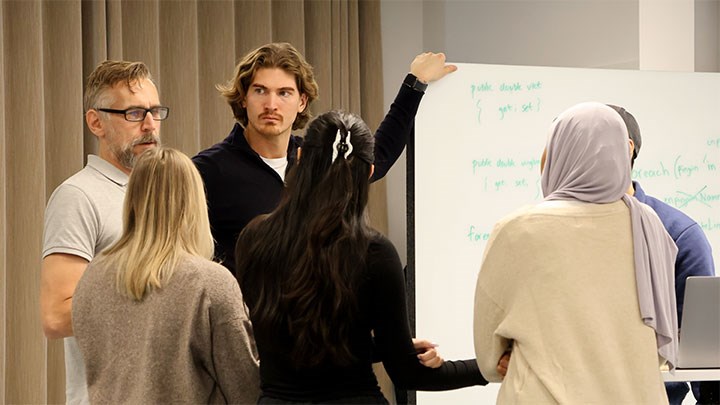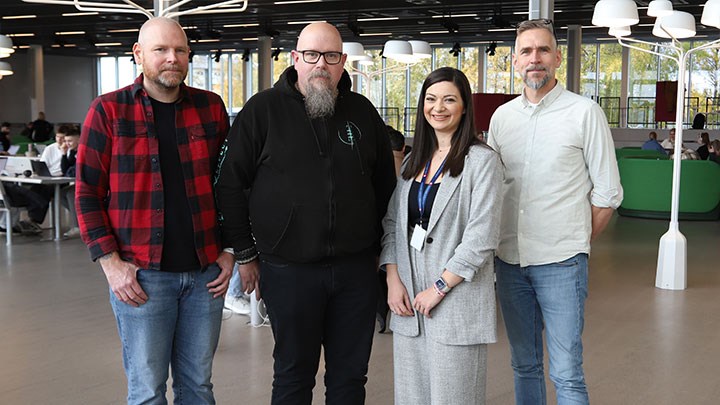Active students achieve better results – the Walkshop model wins teaching award

In Learning Lab, rooms are designed flexibly – ORU walls can be folded and written on.
Students walk around the classroom, writing on the walls – and learn how to program better. Teachers of the Programme of Systems Analysis at Örebro University have developed an innovative teaching method. A model that has also won the Swedish Information Systems Academy (SISA) teaching award.
Why the Walkshop model won – the jury’s motivation:
“This contribution deserves the highest rating in all criteria. Its communication is clear, accessible and reaches the right audience. The Walkshop model focuses on students’ learning, and as a teaching method, it can potentially increase interest in informatics. Its subject relevance is evident and can promote subject didactic development. The contribution possesses the potential to be long-lasting and to spread excellent teaching methods to others. In summary, it is well deserved and is worthy of being rewarded with SISA’s teaching award.”
Source: Swedish Information Systems Academy (SISA).
Forget a lecture hall with a teacher standing in the front, lecturing to a group of note-taking students. Forget classic coding exercises with students solving a class assignment independently, staring into a computer, with their help coming from their notes and course literature.
Poor performance in the programming courses made the Programme of Systems Analysis teachers at Örebro University rethink their course model.
”We know that the first programming course is difficult and saw that the traditional teaching methods worked poorly. Many of our students have never programmed before, so this is entirely new to them,” explains Johan Petersson, senior lecturer and researcher in informatics at the Örebro University School of Business.
Utilise the room and write on the walls
The result was an innovative teaching method that has grown over the past decade, known as walkshops. The students are randomly divided into groups to avoid the stress of having to choose or be chosen. The tasks to be solved are posted on the walls, which can also be written on, in classrooms where the students walk around.
“It’s a lot about how we utilise the premises, especially the walls. In our Learning Lab here at Örebro University, It’s possible to create rooms within the room, thanks to the fold-out ORU walls, all of which can be written on.”

If there are no writable walls, then whiteboards can be used.
“Just the fact that all students stand up is enormously beneficial. It provides active learning where the students drive the work forward and determine the pace,” says Johan Petersson.
Learn from each other
For two hours, the students work step by step with the different tasks together. Now and then, they are also encouraged to talk to another group and share each other’s answers.
“We call it collaborative learning: working together towards a common goal and at the same time practising generic abilities such as making your voice heard, explaining and listening.”
Students learn from one another, and senior students from an advanced course, alongside the teacher, circulate to listen and provide help. This working method also takes advantage of beginner groups, often having a few students with prior knowledge.
“Previously, I always felt a bit guilty of those in the group who already knew how to program. There are almost always a few students who know a little more. In this way, they got an important role and the opportunity to develop by explaining to others,” says Johan Petersson.
Students receive feedback
“As a teacher on your own with 90 students, it’s not always easy to provide feedback the students deserve. But this new method makes that possible,” says Johan Petersson.
“When I hold a lecture in front of a group, on an occasion, one student might raise their hand and ask a question. First, five weeks later, when it was time for an exam, I would see if they had understood. Now, I walk around, keeping an eye out to see if I should step in and explain or give a hint to help them further along. That makes it easier to say, ‘Good that you’re thinking that way. Perhaps next time you can also try this…’” he says.

One goal is for the students to gain insight into their own learning process and reflect on how they learn something. Halfway through the lesson, they take a break and discuss their group’s progress and how they could contribute to the group.
“Upon reflection, maybe someone believes they’ve talked too much or too little. Then they get a new chance to have a say and make for an even better work group.”
Positive response from the students
Instead of the students just getting the solution to an exercise after a walkshop, they watch a video where Johan or one of his colleagues solves the exercise, explaining the concepts and methodology involved.
“The pedagogical thinking behind it is learning by imitation, that is, emulating a person who is good at what they do. Students can code while watching the video at home.”
Since the study programme started with walkshops, students’ results have increasingly improved after the first programming course. There has also been a positive response from the students.
“Students have said that it’s lots of fun, too. We’ve even seen how they get to know each other better as classmates. That they enjoy these methods is also important,” says Johan Petersson.
Winner of Excellent Teaching Award
The Walkshop method has stirred interest not only at Örebro University but also around Sweden. Teachers from other universities have been to Örebro on study visits to learn more. Earlier this autumn, Johan Petersson and his colleagues were also in Borås. The method was nominated for an annual teaching award that the Swedish Information Systems Academy presents. SISA is an interest organisation for institutions that teach informatics and systems science.

In fact, the team from Örebro took home the top prize, and their Walkshop model won SISA’s teaching award for 2023.
“Being recognised for our teaching efforts is perhaps more challenging than on the research side. Although it was fun even before we won, this is inspiring on a different level! We’ve been doing this as a research project, resulting in our developing a model that we’ve evaluated together with students and then continued to develop. Winning a prize for your efforts makes us even more enthusiastic about trying other innovative ideas.”
What’s the next step?
“We’ve introduced the use of generative AI, and we’re teaching students to use Chat-GPT in a smart way. The students appreciate it very much. While it’s an effective tool, it’s not always right. And since they’ll have access to such tools when they enter the workforce, they’ll need to apply their knowledge and critical thinking,” says Johan Petersson.
Text: Anna Lorentzon
Photo: Magnus Hansson/Anna Lorentzon
Translation: Jerry Gray
The Walkshop model’s key concepts
Active learning: Students actively participate in their learning process through discussion, problem-solving and practical exercises.
Collaborative learning: Students work in groups to understand a subject or solve a problem.
Peer Learning: Students learn with and from each other, sharing knowledge and experiences.
Scaffolding: Teachers provide supportive structures that are situationally dependent to help students increase their understanding, with decreasing support as students grasp the learning concepts.
Formative feedback: Continuous, constructive feedback helps students know where they are, what they’re doing, and what’s coming next.
Metacognitive development: The process where students, through increased awareness of their own thinking, learning and results, adapt their approach as necessary.
Modelling: The teacher demonstrates a skill or concept for students to imitate while, at the same time, learning from practical examples.
This is Learning Lab
Learning Lab is a test environment for learning located in Långhuset at Örebro University. Here, teachers and students explore future learning environments together.
How has the Learning Lab environment helped develop the Walkshop model?
”Learning Lab has played a very significant role in tweaking and refining the method. We’ve also used the P2 room quite a lot. However, I want to emphasise that we worked like this even before we had access to these specialised rooms. I believe it’s more a question of how you use the room than the room itself. That we at ORU continue developing our flexible learning environments, I think, is of enormous importance. It’s noticeably apparent by students’ enthusiasm that they’re extra motivated by the feeling that these rooms are designed for them,” says Johan Petersson.
Read more about Learning Lab Örebro.
